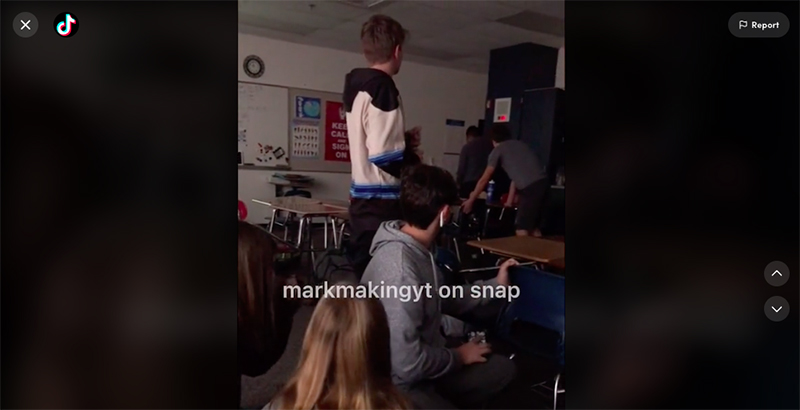‘Look at My Badge, Bro’: Viral Video Inside Shooting-Scarred Michigan School Prompts Conversation about Active Shooter Drills

Get stories like these delivered straight to your inbox. Sign up for The 74 Newsletter
During a mass school shooting Tuesday that left four students dead, teens in one Michigan classroom were forced to grapple with whether they should trust emergency responders — or if someone claiming to be the police was the gunman in disguise.
The incident, captured in a viral social media post from inside Oxford High School, has ignited a conversation about the role of active-shooter drills and how students — and police — should respond during a deadly event. A 15-year-old boy was taken into custody and accused of carrying out the shooting in Oxford Township, home to roughly 22,000 people about 30 miles north of Detroit. Along with the four fatalities, seven others, including a teacher, were wounded. Police reportedly detained the suspect within five minutes of receiving the first 911 call.
On Wednesday, prosecutors charged the suspect as an adult with terrorism and four counts of first-degree murder, in addition to assault with intent to murder and firearms charges. The high school sophomore, who faces possible life in prison, pleaded not guilty during a Wednesday arraignment. Officials said he fired more than 30 rounds from a semiautomatic handgun before being arrested and that a motive had not yet been established. The student had a meeting with school officials the day before the shooting to discuss concerning behavior in the classroom, according to police, and on the morning of the shooting met with them again. At that second meeting, the boy’s parents were called to the school. Afterward, the accused shooter went back to school.
Some three hours later when gunshots rang out, a group of Oxford students, who had barricaded themselves in a classroom, appear confused and hesitant in the video uploaded to TikTok when a man yells through the classroom door and identifies himself as a member of the sheriff’s office. “It’s safe to come out,” he can be heard yelling in the video. But students remained skeptical, with one person in the classroom responding “We’re not willing to take that risk right now.”
“Come to the door and look at my badge, bro,” the man in the hallway says, a response that one student calls a “red flag” and prompts everyone to flee. Students in a panic climb out a classroom window and run across a courtyard to safety.
Oakland County Sheriff Michael Bouchard told reporters Wednesday that the voice on the other side of that door was not the gunman and was likely a plainclothes police officer “talking, ‘bro’ in a conversational manner to try to bring them down from the crisis.” School safety experts told The 74 Wednesday that law enforcement should not have been trying to get into a lock-downed classroom by coaxing students to open the door. While they affirmed the students’ decision to ignore those entreaties, one pointed to several other actions taken during those critical moments that could have put their lives at risk.
@shwifty766 All prayers out for Oxford high school and to all my classmates ##prayers ##prayersneeded ##oxfordhighschool ##fyp ##fypシ ##capcut
♬ original sound – ItsShwifty
Mo Canady, executive director of the National Association for School Resource Officers, a trade group for campus police, commended the officers who apprehended the suspect just minutes after shots were fired and when he still had 18 rounds of ammunition in his possession. Among the arresting officers was a sheriff’s deputy assigned to patrol the school full time. Though research on the efficacy of school-based police remains mixed — and data suggest they’re ineffective at preventing shootings or limiting fatalities — Canady said they’re critical when tragedy unfolds, as it did in Michigan.
“When you can get a suspect in custody or end the shooting in five minutes or less, that’s a win,” he told The 74. The shooting, he said, could have been worse had an officer not been stationed on campus.
He maintained, however, that officers should never knock on doors during campus shootings or ask students to let them into classrooms. Instead, officers clearing the building should have access to a master key so they can enter classrooms “in a non-threatening way.”
“The doors are secured for a reason: Once you’re locked in, you don’t move until the threat comes into the classroom or an authority figure opens that door and lets everyone know it’s clear,” Canady said. The video showing the students’ unwillingness to open the classroom door suggests “that this is a school that has trained properly on lockdowns and trained students as to what to do.”
Law enforcement officials said the 15-year-old suspect came out of a school bathroom and started shooting people in the hallway, killing Justin Shilling, 17; Hana St. Juliana, 14; Madisyn Baldwin, 17; and Tate Myre, 16 and wounding the other victims, four of whom remained hospitalized Thursday.
Michigan law requires schools to conduct three safety and security drills each year and Oxford students reported undergoing active shooter drills just weeks ago. It’s unclear how students in the classroom were trained to respond when someone appears outside a locked classroom door during an emergency. The Oxford district has contracted with the ALICE (Alert, Lockdown, Inform, Counter, Evaluate) Training Institute, a controversial active-shooter training program that recommends confronting shooters as a last resort. The training offers instruction on how to barricade rooms, how to communicate with police and how to use the time in lockdown to prepare for an escape, according to the company website. The company didn’t respond to a request for comment.
The ALICE training likely saved lives, Bouchard, the Oakland County sheriff, said during a press conference Wednesday. Evidence inside the school — including desks used to barricade classroom doors, some peppered with bullet holes — suggest that students used the training to protect themselves.
ALICE and other active-shooter drills have been the subject of fierce opposition in recent years amid concerns they traumatize students. Almost all schools nationally conduct regular active shooter drills, according to the National Center for Education Statistics.
School safety researcher Jaclyn Schildkraut, an associate criminal justice professor at the State University of New York at Oswego, maintains that active-shooter drills remain critical, with her research suggesting that they foster “a culture of preparedness in schools.” Schildkraut said the Oxford students made the right call when they refused to open the classroom door. But the video, she said, shows several other choices that could have put their safety at risk.
Schildkraut, who trains students how to respond to active shooters using materials from The “I Love U Guys” Foundation, said the students should have refrained from engaging at all with the person on the other side of the door. A better response, she said, would have been to maintain silence and act like the room is empty. Additionally, students’ decision to bolt out the window may have been dangerous if they didn’t know the gunman’s precise location. In an attempt to flee, she said they could have increased their chances of getting shot.
She also had concerns with the student filming the situation as it unfolded. Documenting the incident with their phone could have put that student in greater danger, she said, because “they’ve lost a focus and awareness on what’s going on around them.”
While Schildkraut and Canady maintained that students should never open a locked door during an active shooting, Jeff Soli, president of the Schools, Educators, Police Liaison Association in Michigan and a sergeant for the Fowlerville Police Department, offered a slightly more lenient perspective. Soli’s group trains school-based officers at its annual conference, including on active shooter drills, and the school-based deputy who apprehended the suspected Oxford shooter attended its event earlier this year, he said.
Soli said he doesn’t advise against students communicating with others through locked classroom doors.
“You don’t open the door unless you can identify who it is,” he told The 74. “Don’t open the door unless you’re 100 percent sure there’s an officer on the other side or the principal or someone like that.”
Get stories like these delivered straight to your inbox. Sign up for The 74 Newsletter


